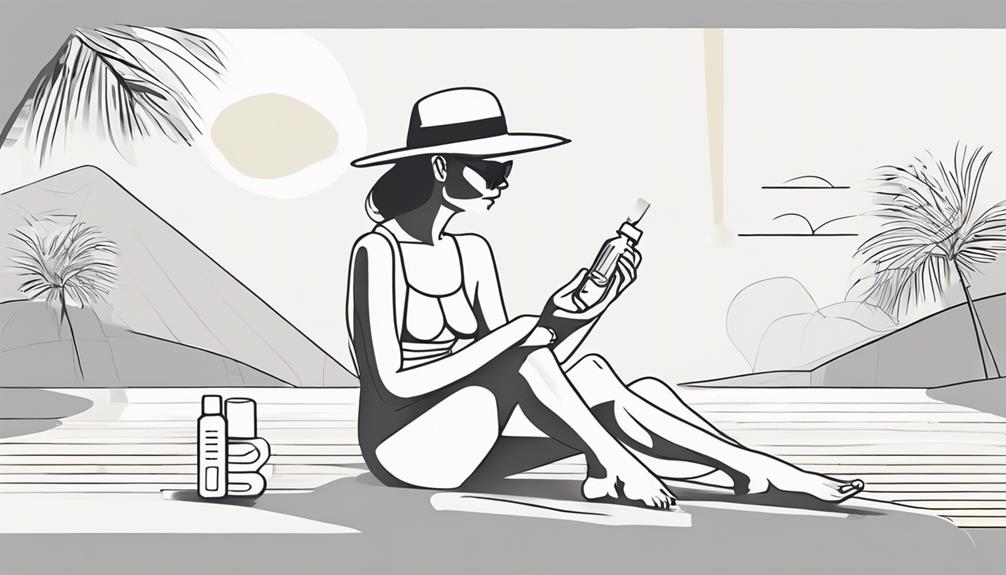In the realm of sun safety, understanding the intricate dance between ultraviolet radiation and our skin is paramount. While the sun offers essential benefits like vitamin D synthesis, its UV rays can also pose significant risks. From the importance of proper sun protection methods to the selection of appropriate sunscreen, a comprehensive approach is crucial in safeguarding our skin health. Yet, beyond the basics lies a nuanced world of sun safety practices waiting to be explored. So, let's delve into the depths of sun protection strategies with a critical eye towards enhancing our understanding and implementation of preventive measures.
Key Takeaways
- Use SPF 30+ sunscreen and reapply every 2 hours.
- Seek shade, wear protective clothing, and wide-brim hats.
- Understand UV radiation, peak times, and signs of sun damage.
- Choose broad-spectrum sunscreen with UPF-rated clothing for comprehensive protection.
Importance of Sun Protection

The significance of sun protection in mitigating the harmful effects of ultraviolet (UV) rays on the skin cannot be overstated. Sun exposure is a primary cause of skin cancer, with UV rays damaging the DNA in skin cells, leading to mutations that can result in skin cancer development. Using sunscreen is a fundamental aspect of sun protection. Sunscreens with a Sun Protection Factor (SPF) of 30 or higher are recommended to shield the skin from UV rays effectively. Reapplication of sunscreen every two hours, especially after swimming or sweating, is crucial in maintaining its efficacy. Applying sunscreen at least 30 minutes before going outside allows the skin to absorb the product adequately, enhancing its protective abilities.
In addition to sunscreen, other sun safety practices such as seeking shade, wearing protective clothing like long sleeves and hats, and using sunglasses can further reduce the risks of sun damage. By incorporating these measures into daily routines, individuals can significantly lower their chances of experiencing sunburn, eye damage, premature aging, and ultimately, skin cancer.
Choosing the Right Sunscreen
Selecting the appropriate sunscreen involves considering its SPF rating and whether it offers broad-spectrum protection, crucial for shielding against harmful UV rays. Understanding the significance of these factors can aid in reducing the risk of skin damage and maintaining skin health. Therefore, choosing a sunscreen that meets these criteria is vital for effective sun protection.
Sunscreen SPF Ratings
Opt for sunscreens with SPF 30 or higher to ensure effective protection against harmful UVB rays. SPF (Sun Protection Factor) indicates how well the sunscreen protects against UVB rays. An SPF 30 sunscreen blocks about 97% of UVB rays, while SPF 50 blocks about 98%. It's important to note that higher SPF doesn't translate to double the protection; the increase in protection is minimal. Remember to reapply sunscreen every 2 hours to maintain protection, regardless of the SPF. Consistent reapplication is key to ensuring continuous coverage and safeguarding your skin from sun damage.
| SPF Level | UVB Ray Protection (%) | Reapplication Frequency |
|---|---|---|
| SPF 15 | 93% | Every 2 hours |
| SPF 30 | 97% | Every 2 hours |
| SPF 50 | 98% | Every 2 hours |
Broad Spectrum Protection
For effective protection against harmful UV rays, it is crucial to choose a broad-spectrum sunscreen that guards against both UVA and UVB radiation. Broad-spectrum sunscreens with SPF 15 or higher help reduce the risk of skin cancer and premature aging caused by UV exposure. When selecting a sunscreen, opt for water-resistant formulations to maintain protection during activities like swimming or sweating. It's important to note that sunscreens labeled as waterproof or sweat-proof can be misleading, as no sunscreen is entirely impervious to water. To ensure optimal protection, always choose a sunscreen that meets FDA safety and efficacy standards. By prioritizing broad-spectrum protection, individuals can safeguard their skin against the damaging effects of UV rays effectively.
Clothing as Sun Protection

When considering protection from the sun, the choice of clothing plays a crucial role in minimizing UV exposure and reducing the risk of skin damage. Clothing acts as a physical barrier against harmful UV rays, with certain types of fabrics and designs offering better sun protection than others. Here are some key points to keep in mind when selecting clothing for sun protection:
| Key Aspect | Description |
|---|---|
| Fabric Weave | Opt for tightly woven fabrics that block more UV rays compared to loose weaves. |
| Color Choice | Dark-colored clothing provides greater UV protection by absorbing sunlight and blocking rays. |
| Coverage | Long-sleeved shirts and pants offer more coverage against UV exposure than short sleeves. |
| UPF Rating | Clothing with a UPF (Ultraviolet Protection Factor) rating provides enhanced defense against UV rays, akin to sunscreen. |
| Hat Design | Wide brim hats help shield the face, neck, and ears from direct sunlight, reducing the risk of sunburn and skin damage. |
Understanding UV Radiation
UV radiation, comprising UVA, UVB, and UVC rays, presents significant concerns for skin health and overall well-being. UVA rays deeply penetrate the skin, contributing to premature aging and an increased risk of skin cancer, while UVB rays primarily affect the skin's superficial layers, causing sunburn and skin cancer. The intensity of UV radiation fluctuates based on factors such as time of day, season, altitude, and cloud cover, with peak levels typically occurring between 10 a.m. and 4 p.m. The UV Index serves as a tool to gauge the strength of UV radiation, aiding individuals in determining the necessary sun protection measures for a specific day and location. Overexposure to UV radiation can result in immediate consequences like sunburn and eye damage, as well as long-term effects such as skin cancer and premature aging. Understanding the distinction between UVA and UVB rays, monitoring the UV Index, and employing adequate sun protection, including sunscreen with a high sun protection factor (SPF), are crucial steps in safeguarding against the harmful effects of UV radiation.
Eye Protection in the Sun

When considering eye protection in the sun, it is crucial to prioritize sunglasses that offer UV400 rating or 100% UV protection to shield the eyes effectively. Opting for light-tinted glasses in shades like green, amber, red, or gray ensures proper UV defense compared to dark-tinted lenses, which may not guarantee UV protection. Consulting an eye care professional is advisable to confirm the level of UV protection in tinted glasses and mitigate potential risks of eye damage due to increased UV exposure from dilated pupils when wearing sunglasses.
Sunglasses for UV Rays
To safeguard your eyes from harmful UV rays, it is crucial to select sunglasses with a UV400 rating or those labeled as providing 100% UV protection. When it comes to eye safety and UV protection, not all tinted glasses are created equal. Here are some key points to consider:
- Dark-tinted lenses do not guarantee UV protection; opt for sunglasses labeled as providing 100% UV protection.
- Light-colored tinted glasses like green, amber, red, and gray can offer UV protection along with a touch of style.
- Consult an eye care professional to verify UV protection in tinted glasses for optimal eye safety.
Importance of Shades
Sunglasses play a crucial role in safeguarding the eyes against the harmful effects of solar radiation, emphasizing the necessity of proper eye protection in sunlit environments. Protecting the eyes from UV rays is essential in maintaining good eye health. To ensure optimal protection, it is recommended to choose sunglasses with UV protection that block 100% of UVA and UVB rays. Additionally, wearing a wide-brimmed hat can complement eye protection by reducing direct sunlight exposure. By taking these measures, the risk of long-term damage such as cataracts and other eye issues due to prolonged UV exposure can be minimized, promoting overall eye health.
| Importance of Shades | Effects on Eye Health |
|---|---|
| UV Protection | Shields from harmful rays |
| Wide-Brimmed Hat | Reduces direct sunlight exposure |
| Proper Eye Protection | Minimizes long-term damage |
Sun Safety for Children
Children's delicate skin necessitates vigilant sun safety measures to mitigate the risks associated with UV exposure. When it comes to protecting children from the sun, here are some key strategies to follow:
- Use Appropriate Sunscreen: Opt for sunscreen with a minimum SPF of 15 and apply it generously to all exposed skin. Remember to reapply every 2 hours, especially after swimming or sweating.
- Dress in Protective Clothing: Encourage children to wear protective clothing such as hats, sunglasses, and long sleeves to shield their skin from harmful UV rays. This can provide an additional layer of defense against sunburn and skin damage.
- Avoid Peak Sun Hours: Limit outdoor activities during peak sun hours, typically between 10 a.m. and 2 p.m., when the sun's rays are the strongest. This can significantly reduce children's exposure to UV radiation and lower the risk of sunburn and related issues.
Sun Exposure and Vitamin D

Sun exposure plays a crucial role in the production of vitamin D, a vital nutrient for bone health and immune function. The duration of sun exposure needed for adequate vitamin D synthesis can vary based on factors like skin tone and geographical location. Understanding the balance between sun safety and obtaining sufficient sun exposure is essential for maintaining optimal vitamin D levels.
Vitamin D Production Process
Exposure to sunlight initiates the skin's synthesis of vitamin D, a vital nutrient essential for bone health and immune system function. When considering the Vitamin D production process, it's crucial to understand the intricate mechanisms at play:
- UVB Rays Interaction: Ultraviolet B (UVB) rays from the sun interact with cholesterol in the skin to kickstart the synthesis of vitamin D.
- Factors Affecting Production: The amount of vitamin D produced varies based on factors such as time of day, season, skin color, and the use of sunscreen.
- Balancing Act: Finding a balance between sun exposure for vitamin D synthesis and sun protection to prevent skin cancer is key to maintaining optimal health.
Sun Exposure Duration
Given the intricate relationship between sunlight exposure and the production of Vitamin D in the skin, understanding the optimal duration of sun exposure becomes paramount in maintaining a delicate balance between reaping its benefits and safeguarding against potential risks. Spending 5-15 minutes in the sun without sunscreen 2-3 times a week can aid in ample Vitamin D production. However, prolonged exposure to UV rays without protection can lead to skin damage and increase the risk of skin cancer. The duration required for Vitamin D synthesis varies depending on factors like skin type, time of day, and location. For the most effective synthesis, sun exposure is recommended when the sun is high in the sky, typically between 10 a.m. and 3 p.m. It's crucial to pair sun exposure for Vitamin D with sun safety practices such as wearing sunscreen and protective clothing.
Signs of Sun Damage
Indications of skin damage caused by excessive ultraviolet radiation from the sun encompass a range of visible and potentially concerning effects. These signs serve as crucial warnings of potential harm that can arise from inadequate protection against UV rays and extended sun exposure. Understanding and recognizing these manifestations can prompt individuals to take proactive measures to safeguard their skin health. The following list outlines some key signs of sun damage:
- Sunburn: Characterized by red, painful skin that may blister, sunburn is a clear indicator of skin damage due to UV radiation.
- Premature Aging: Prolonged sun exposure can lead to premature aging, evidenced by wrinkles, dark spots, and sagging skin.
- Actinic Keratosis: The development of rough, scaly patches on the skin, known as actinic keratosis, signals sun damage and an increased risk of skin cancer.
Sun Safety for Outdoor Activities

Understanding the importance of sun safety practices, particularly during outdoor activities, is paramount in mitigating the risks associated with prolonged sun exposure and UV radiation. To reduce your risk of sun damage while engaging in outdoor activities, it is crucial to take proactive measures. One key aspect is the use of sun protection factor (SPF) to shield your skin from harmful UV rays. Applying SPF 30 broad-spectrum sunscreen 30 minutes before sun exposure and reapplying it every two hours, especially when sweating or in water, can provide effective protection. Additionally, wearing UPF sunwear, wide-brim hats, and sunglasses can further minimize your exposure to UV rays. Seeking shade under umbrellas or trees is also beneficial in reducing the direct impact of the sun on your skin. By incorporating these sun safety practices into your outdoor routine, you can enjoy activities under the sun while safeguarding your skin health.
| Sun Safety Tips | Importance | Implementation |
|---|---|---|
| Wear sunscreen | Protects from UV rays | Apply 30 mins before exposure and reapply every 2 hours |
| Seek shade | Minimizes UV exposure | Stay under umbrellas or trees during peak sun hours |
| Use UPF sunwear/hats/sunglasses | Shields skin/eyes from sun | Wear for added protection during outdoor activities |
Incorporating Sun Safety Into Daily Routine
Incorporating sun safety into one's daily routine is essential for protecting the skin from harmful UV rays and reducing the risk of sun damage. To achieve this, individuals can follow these key steps:
- Apply Sunscreen: Utilize broad-spectrum sunscreen with an SPF of 15 or higher daily to shield the skin from UV rays that can cause damage.
- Stay in the Shade: Seek shade during peak sun hours, typically between 10 a.m. and 2 p.m., to minimize UV exposure and lower the risk of skin damage.
- Wear Protective Clothing: Enhance sun safety by wearing protective clothing such as hats, long-sleeve shirts, and sunglasses to provide additional defense against harmful UV rays.
Frequently Asked Questions
How Can We Be Safe From Sunlight?
To be safe from sunlight, individuals should prioritize sunscreen application to shield against harmful UV rays. Seeking shade during peak sun hours and wearing protective clothing, like long-sleeve shirts and wide-brim hats, are essential. Staying hydrated and applying sunscreen every 2 hours, especially after sweating or swimming, is crucial for maintaining protection. Additionally, wearing sunglasses that block UVA and UVB rays is vital to safeguard eyes from sun damage.
What Are 5 Sun Safety Tips?
Implementing sun safety measures is crucial for skin protection. Begin by applying sunscreen with SPF 15 or higher, wear protective clothing like long-sleeve shirts and broad-brim hats, and use sunglasses to shield eyes from UV rays. Take shade breaks during peak sun hours, maintain hydration levels, and remember that up to 80% of UV rays can penetrate clouds, necessitating sun safety practices even on cloudy days. These strategies ensure comprehensive sun protection.
How Can We Protect From the Heat of the Sun?
To protect from the heat of the sun, individuals should prioritize preventing heat exhaustion by seeking shade, staying hydrated, and wearing lightweight, loose-fitting clothing for proper coverage. Additionally, regular application of sunscreen is crucial to shield the skin from harmful UV rays. By incorporating these measures, one can effectively mitigate the risks associated with prolonged sun exposure and maintain overall well-being in hot weather conditions.
How Can I Spend Time in the Sun Safely?
When spending time in the sun, ensure safety through proper sunscreen application, frequent shade breaks, adequate hydration, appropriate clothing coverage, and the use of sunglasses. Sunscreen with SPF 15 or higher should be applied generously and reapplied every two hours. Seeking shade periodically helps reduce UV exposure, while staying hydrated is crucial to prevent heat-related illnesses. Clothing that covers skin and sunglasses that block UV rays provide additional protection against sun damage.
Conclusion
In conclusion, staying safe in the sun is essential to prevent sunburn, premature aging, and skin cancer. Just like a sturdy shield protects a warrior in battle, following sun protection measures such as seeking shade, wearing protective clothing, using sunscreen, and wearing sunglasses can shield us from the harmful effects of UV radiation. By incorporating these practices into our daily routines, we can enjoy the sun safely and maintain healthy skin.
